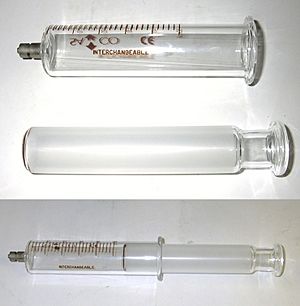Gas syringe facts for kids
A gas syringe is a special tool used in a science lab. It looks a bit like a big medical syringe, but it's made for gases! Scientists use it to collect gases or to measure how much space a gas takes up (its volume).
This handy piece of equipment helps scientists understand how gases behave. It's often used in experiments to show important ideas like the Gas Laws, which explain how the pressure, volume, and temperature of a gas are connected.
Contents
How a Gas Syringe Works
A gas syringe is usually made from clear glass or plastic. This lets you see the gas inside. It has two main parts:
- Barrel: This is the main tube of the syringe. It has markings along its side, like a ruler, to show different volumes. These markings help you measure the gas.
- Plunger: This is a rod with a tight-fitting seal at one end. The plunger slides smoothly inside the barrel. When you pull the plunger out, it draws gas into the syringe. When you push it in, it pushes gas out or compresses it.
The tight seal on the plunger is very important. It stops any gas from leaking out or air from getting in. This makes sure your measurements are accurate.
What Are Gas Syringes Used For?
Gas syringes are super useful in many science experiments. Here are some common ways they are used:
Collecting Gases
When a chemical reaction makes a gas, you can use a gas syringe to collect it. You simply connect the syringe to the container where the gas is being made. As the gas forms, it pushes the plunger out, filling the syringe. This is a clean and easy way to gather gases for further study.
Measuring Gas Volume
One of the main jobs of a gas syringe is to measure the volume of a gas. The markings on the barrel tell you exactly how much gas is inside. This is important for experiments where you need to know the exact amount of gas produced or used.
Studying Gas Laws
Gas syringes are perfect for demonstrating the Gas Laws. For example, you can use one to show:
- Boyle's Law: This law explains that if you keep the temperature the same, the volume of a gas goes down as its pressure goes up. You can push the plunger in to compress the gas and see how its volume changes.
- Charles's Law: This law shows that if you keep the pressure the same, the volume of a gas goes up as its temperature goes up. You can heat or cool the gas in the syringe and watch the plunger move.
These experiments help students understand how gases react to changes in their environment.
Why Gas Syringes Are Important
Gas syringes are simple but powerful tools in chemistry and physics labs. They allow scientists and students to:
- Perform experiments safely with gases.
- Get accurate measurements of gas volumes.
- Understand fundamental scientific principles, especially those related to gases.
They are a key piece of equipment for anyone learning about or working with gases.
See also
 In Spanish: Jeringa de gas para niños
In Spanish: Jeringa de gas para niños


